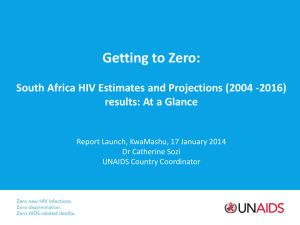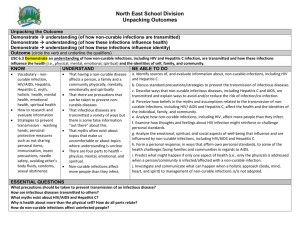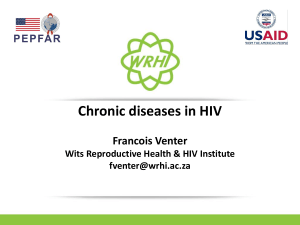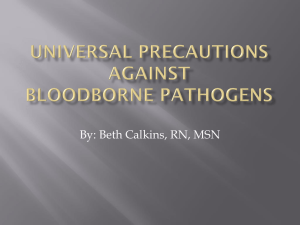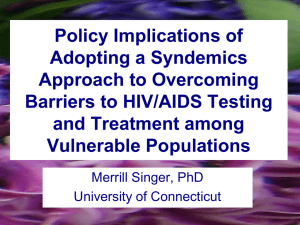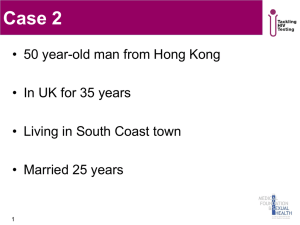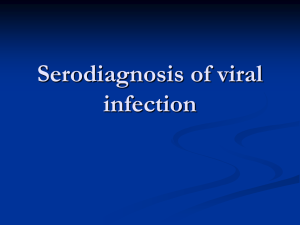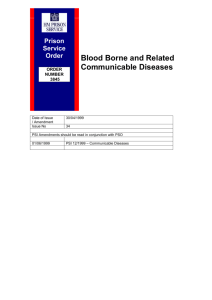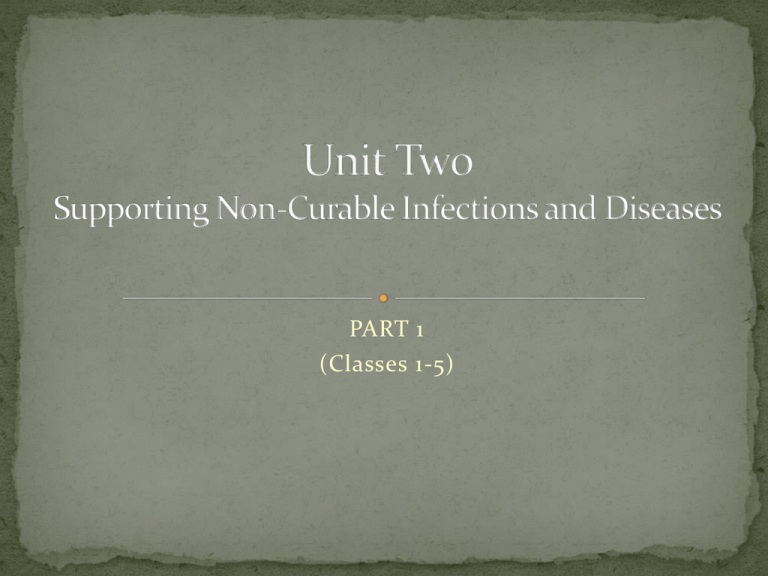
PART 1
(Classes 1-5)
What is an infection? What is a disease?
Definition of non-curable
Examples: notes on various NCIDs
Holistic health charts
Take-Home Assignment (20 marks)
Class Discussions
Representation of Learning (50 marks)
I can show I understand the impact of in/formal
supports for those affected with or affected by noncurable infections and diseases.
Infection: an organism inside of someone which
gets its nourishment from that person, it colonizes
that person and reproduces inside them. The
human with that organism (germ) inside is called
the host.
Parasites
Fungi
Bacteria
It is only considered to be an infection if the organism is
causing harm to the host.
Disease: is any disturbance or anomaly in the
normal functioning of the body that probably has
a specific cause and identifiable symptoms.
A widespread disease is called an epidemic, and a
disease which is global is called a pandemic.
Infectious Disease: a disease as the result of an
infection.
Non-curable or Incurable: describing something for
which there is no cure. This does not mean that the
illness or disease is not treatable.
Example: Cancer can be treated, but there is no cure.
Chronic: Persists for a long time, or constantly
recurring.
Acute: of a short duration but typically severe
Bloodborne pathogen: can be spread by
contamination of blood
Immune System: a system that protects the body
from foreign substances and pathogens by producing
the immune response.
WE WILL BE FOCUSING ON...
Hepatitis C
HIV
Diabetes
Cancer
Lupus
Hepatitis C is only contracted through unprotected sex.
1.
FICTION
Someone with Hepatitis C may eventually need a liver
transplant.
2.
FACT
You shouldn’t hug someone with Hepatitis C because you
might get it
3.
FICTION
Some people’s bodies naturally get rid of Hepatitis C
before it becomes more serious
4.
FACT
A live disease caused by the Hepatitis C virus, which
attacks the liver.
Many people infected never feel sick and completely
recover.
If the body is not able to fight off the virus, one may
develop chronic hepatitis which can lead to cirrhosis
(liver scarring), liver failure and even liver cancer later
in life.
It is considered a “silent” disease because often no
symptoms appear until your liver is severely damaged.
Hepatitis C travels through the blood, and is
contracted when blood infected with the Hepatitis C
virus gets into the blood stream.
Exposure is risked by using injection drugs, getting
tattoos, piercings, pedicures, manicures or medical
procedures with improperly sterilized equipment,
sharing personal hygiene items with an infected
person (razors, toothbrushes, nail clippers), or having
had a blood transfusion prior to July 1990.
Symptoms often do not appear until the liver is
severely damaged.
Many people never feel sick and completely recover.
Others get a brief, acute illness with fatigue, loss of
appetite, and skin and eyes turning yellow (jaundice)
If the body is not able to fight the virus, chronic
hepatitis is developed, which can lead to cirrhosis,
liver failure and liver cancer later in life.
Once you have developed Hepatitis C and your body
cannot fight it off, you will always have the virus in
your body.
Regular exercise and healthy eating is the best way to
manage the chronic fatigue that is associated with
Hepatitis C.
For some patients, drug treatment may be appropriate.
This consists of a combination of injections once a
week (administered by a physician) and pills taken
daily.
Human Immunodeficiency Virus
HIV weakens the immune system, leaving the body
unable to fight off certain infections.
When a person has HIV and becomes sick from one or
more of these infections, they have AIDS.
AIDS stands for Acquired ImmunoDeficiency
Syndrome
Although there is no cure for HIV, with proper care
and treatment most people with HIV can avoid getting
AIDS and stay healthy for a long time.
HIV can only be contracted by the virus entering the
bloodstream.
The virus can be transmitted through blood, vaginal
fluids, semen, and breast milk.
A person can get HIV by having unprotected sex, by
sharing needles or other drug use equipment, razors or
toothbrushes that have blood on them. Females can
pass the virus to babies while breastfeeding.
HIV CANNOT BE PASSED through casual contact
such as hugging, kissing, shaking hands, sharing food
or toilet seats.
A person can have HIV and not know it because there
may be no symptoms for many years.
A mild flu may be developed 2-4 weeks after becoming
infected.
HIV prevents the body from fighting off otherwise
harmless infections, like the flu and can develop into
AIDS.
Eventually, an infected person can become sick with
life threatening infections.
Anti-HIV drugs must be taken every day to keep it
under control.
Today there are 31 antiretroviral drugs approved to
treat HIV.
These drugs suppress the virus, even to undetectable
levels, but do not completely eliminate HIV from the
body.
Individuals who are medicated for HIV can still
transmit the virus to others, and must continuously
take these drugs in order to maintain their health
quality.
Diabetes describes a group of metabolic diseases in which a
person has high blood sugar
Either because insulin production is inadequate
And/or because the body’s cells do not respond properly to
insulin
There are three types of Diabetes:
Type 1 Diabetes: the body does not produce insulin. Usually
developed in early adulthood or teenage years
Type 2 Diabetes: the body does not produce enough insulin
for proper function. 90% of all diabetes cases are type 2.
Gestational Diabetes: Affects females during pregnancy.
High levels of glucose in the blood, and the body is unable to
produce enough insulin to transport it all.
Diabetes is genetic.
People most at risk include someone of Aboriginal,
Hispanic, Asian, South Asian or African descent, and
individuals who are overweight (will most of the weight
carried around the middle)
Other people at high risk include those who have:
A parent, brother or sister with diabetes
Health complications associated with diabetes
Given birth to a baby over 9 pounds
Had gestational diabetes
High blood pressure
High cholesterol or other fats in the blood
Unusual thirst
Frequent urination
Weight change (gain or loss)
Extreme fatigue or lack of energy
Blurred vision
Frequent or recurring infections
Cuts and bruises that are slow to heal
Tingling/numbness in hands or feet
Lifestyle changes (healthy meal plan, weight control,
physical activity) can help prevent or delay the onset of
type 2 diabetes.
Physical activity
Nutrition
Weight management
Medication
Type 1 is always treated with insulin
Type 2 may require medications/insulin along with healthy
lifestyle changes
Stress reduction
Blood pressure
Cancer is a disease cause by an uncontrolled division of
abnormal cells in a part of a body, leading to a malignant
growth or tumor.
Cancer cells can spread to other parts of the body through
blood and lymph systems.
There are more than 100 types of cancer.
Main categories:
Carcinoma
Sarcoma
Leukemia
Lymphoma and myeloma
Central nervous system cancers
All cancers begin in cells.
The genetic material (DNA) of a cell can become
damaged, producing mutations that affect normal cell
growth and division.
Cells do not die when they should, and new cells form
when the body does not need them. These extra cells
can form a mass of tissue called a tumor
There are so many different types of cancer and many
symptoms that go with them.
The first sign that a malignant tumor has spread is
often swelling of nearby lymph nodes, but can
metastasize to almost any part of the body.
It is important to know one’s family history and
understand the signs to look for to ensure that cancer
is found in it’s earliest stages
http://cancergameplan.ca/blog/2012/07/idhatetobefra
nk/
There are different ways to manage the many types of
cancer, but no cure.
Radiation: use of high-energy radiation to kill dancer cells by
damaging their DNA. Must be carefully plan as radiation can
damage healthy cells as well.
Chemotherapy: drugs which are put into the body to kill
cells that divide rapidly.
Removal: surgery to go in and take out infected cells when
possible.
The most important part of effective management is
knowing your body and paying attention to any warning
signs.
Check for differences in the body and keep track of changes
carefully.
A chronic autoimmune disease in which the immune
system forms antibodies that attack healthy tissues and
organs.
May be a mild disease that affects only a few organs; or may
become life-threatening.
Discoid Lupus: affects skin, causing a rash and lesions
usually across the face and upper part of the body.
Systemic Lupus erythemastosus: can attack any body
organ or system such as joints, kidneys, brain, heart and
lungs. If not controlled, can be life threatening.
Drug-induced Lupus: a reaction to medication
Doctors do not know exactly what causes lupus,
however most believe it results from both genetic and
environmental stimuli.
It is believed to be possible to inherit a genetic
predisposition to lupus. It is possible that this makes
the disease more likely only after coming into contact
with some environmental trigger:
Extreme stress
Exposure to ultraviolet light (usually from sunlight)
Smoking
Some medications & antibiotics
Some infections, including Fifth Disease and Hepatitis C
Achy joints, arthritis, swollen joints
Swelling of hands and feet due to kidney problems
Fever of over 38 degrees C
Prolonged or extreme fatigue
Skin lesions or rashes
Butterfly-shaped rash across cheeks and nose
Anemia
Pain in chest on deep breathing, shortness of breath
Hair loss or alopecia
Sun or light sensitivity
Abnormal blood clotting problems
Seizures
Dry eyes
Easy bruising
.........
Early diagnosis and proper medical treatment can
significantly help control the disease and symptoms
Minimizing symptoms, reducing inflammation pain,
helping maintain normal function, and preventing
serious complications.
Treatments are usually tailored to the specific
problems that arise in each person.
Medication and dosages with vary depending on the
severity of the disease.
Complete the following chart about how non-curable
infections and diseases affect the individual, family,
and community of the individual when there are no
supports available.
Individual
Physical
Mental
Spiritual
Emotional
Family
Community
Explore the recommended follow-up procedures and
supports for those who test positive for HIV /15
2. Talk about how HIV testing is a support service. /5
1.
Roughly ½ page per question.
How can formal/informal supports affect individuals
dealing with NCIDs?
Families of individuals dealing with NCIDs?
Communities of individuals dealing with NCIDs?
Be able to:
Describe the effects of non-curable infections/diseases,
including HIV and Hepatitis on families and communities.
(CHART)
Recognize that some non-curable infections, including HIV,
are linked to risky behaviours and not to particular groups of
people, and use this knowledge to determine when people
should be tested for HIV.
Examine the types of informal and formal community
supports available for people infected and/or affected by noncurable infections/diseases, including HIV/AIDS and
Hepatitis C.
Consider the impact that education has on the kinds of
supports available in communities for people infected
with/affected by non-curable infections.

